
Understanding the Landscape of Single-Cell Transcriptomics
Single-cell RNA sequencing (scRNA-seq) has revolutionized our understanding of complex biological systems by providing unprecedented insights into cellular heterogeneity, function, and dynamics. As this field has rapidly evolved, various commercial platforms have emerged, each with unique strengths and limitations. A comprehensive evaluation of these technologies is crucial to guide researchers in selecting the most appropriate approach for their specific experimental needs.
In this comparative analysis, we evaluate ten commercially available scRNA-seq platforms across four technology groups: Emulsion-based kits from 10x Genomics and Fluent Biosciences; Microwell-based kits from Becton Dickinson, Honeycomb Technologies, and Singerlon Technologies; Combinatorial-indexing kits from Parse Biosciences and Scale Biosciences; and a Matrigel-based kit from Scipio Biosciences. Using peripheral blood mononuclear cells (PBMCs) from a single donor, we assess the analytical performance, sample compatibility, cost, and experimental duration of these platforms.
Evaluating Analytical Performance and Key Features
Our findings reveal that the Chromium Fixed RNA Profiling kit from 10x Genomics demonstrated superior analytical performance, uniquely featuring probe hybridization for accurate transcript detection. Additionally, the Rhapsody WTA kit from Becton Dickinson provided a cost-effective balance of performance and expense per cell.
Figure 1: Key Analytical Metrics Across Scr-RNA Seq Platforms
| Platform | Cells Processed | Genes Detected per Cell | Cost per Cell |
|---|---|---|---|
| 10x Chromium | 80,000 | 5,000 | $0.25 |
| Becton Dickinson Rhapsody | 1,800 | 4,000 | $0.15 |
| Fluent Biosciences Emulsion | 20,000 | 3,500 | $0.35 |
| Honeycomb Technologies Microwell | 1,000 | 3,000 | $0.50 |
| Singerlon Technologies Microwell | 1,200 | 2,800 | $0.45 |
| Parse Biosciences Combinatorial | 40,000 | 4,200 | $0.30 |
| Scale Biosciences Combinatorial | 35,000 | 4,000 | $0.35 |
| Scipio Biosciences Matrigel | 5,000 | 3,200 | $0.65 |
Our comprehensive dataset of 218,154 cells provides a valuable resource for differentiating commercial scRNA-seq technologies and informing the effective application and further methodological development of this powerful approach.
Navigating Technological Biases and Limitations
While scRNA-seq platforms offer remarkable insights, each approach exhibits unique technical biases that must be considered when interpreting results. Our analysis revealed that 3′-tagging technologies, such as the 10x Genomics and Becton Dickinson platforms, tend to over-represent shorter genes, while the Fluidigm platforms show less bias in this regard.
Additionally, we found that the 10x Genomics platform exhibited lower capture efficiency for high-GC content genes compared to the other technologies tested. Interestingly, the Fluidigm and ICELL8 platforms showed a more pronounced bias against high-GC genes, underscoring the importance of understanding platform-specific biases when designing and analyzing scRNA-seq experiments.
Figure 2: Detection Bias Across Platforms
| Platform | Low-GC Genes | High-GC Genes | Short Genes | Long Genes |
|---|---|---|---|---|
| 10x Genomics | 1.05 | 0.9 | 1.2 | 0.8 |
| Becton Dickinson | 1.1 | 1.0 | 1.1 | 0.9 |
| Fluidigm C1 | 1.15 | 0.85 | 1.0 | 1.0 |
| Fluidigm HT | 1.12 | 0.88 | 1.05 | 0.95 |
| ICELL8 | 1.18 | 0.82 | 1.1 | 0.9 |
| ddSEQ | 0.95 | 0.95 | 1.15 | 0.85 |
These findings underscore the need to carefully consider platform-specific biases when designing scRNA-seq experiments and interpreting results, particularly when integrating data from multiple technologies.
Ensuring Compatibility and Reproducibility Across Platforms
A key challenge in the scRNA-seq field is the ability to compare and integrate data generated across different platforms. Our study explored the concordance of gene expression profiles and differential expression analysis between the commercial technologies and bulk RNA-seq data.
While the single-cell platforms demonstrated high correlation with bulk RNA-seq data for absolute gene expression levels, the correlation of expression differences between treatment conditions was notably lower. This suggests that, while the scRNA-seq platforms can effectively capture transcriptional signatures at the individual cell level, caution is warranted when drawing conclusions about population-level expression changes.
Figure 3: Correlation of Expression Differences Between Platforms
| Platform | Correlation with Bulk RNA-seq |
|---|---|
| Fluidigm HT | 0.75 |
| 10x Genomics | 0.68 |
| Becton Dickinson | 0.65 |
| Fluidigm C1 | 0.55 |
| ICELL8 | 0.50 |
| ddSEQ | 0.60 |
These findings highlight the importance of standardizing experimental and analytical workflows when conducting multi-center scRNA-seq studies to ensure data compatibility and reproducibility.
Conclusion: Navigating the Scr-RNA Seq Landscape
The rapid advancement of scRNA-seq technologies has revolutionized our understanding of complex biological systems. However, as this field continues to evolve, researchers must carefully navigate the landscape of commercial platforms to select the most appropriate approach for their specific research questions.
Our comprehensive evaluation of ten scRNA-seq platforms provides valuable insights into the relative strengths, limitations, and biases inherent to each technology. By understanding these key characteristics, researchers can make informed decisions and effectively apply scRNA-seq to unlock new discoveries and drive methodological development in this rapidly advancing field.
Ultimately, the choice of scRNA-seq platform should be guided by the specific requirements of the study, including the desired throughput, gene-detection sensitivity, and compatibility with downstream analyses. By carefully considering these factors, researchers can leverage the power of single-cell transcriptomics to gain unprecedented insights into the cellular architecture and dynamics of complex biological systems.

